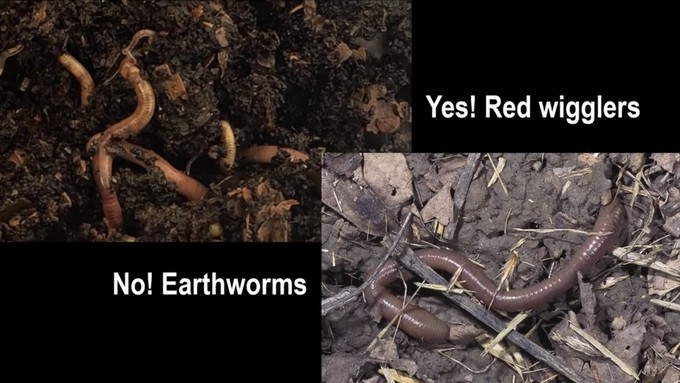
Sacramento video program an award winner

Tips on worm composting -- including the right type of worms -- are in one of the Sacramento County master gardeners' YouTube videos. Screen grab from "Making a Worm Bin"
Darkness has descended on the garden. Even on a clear day now, 4:30 p.m. is dark enough to remind gardeners to put away their tools soon and head indoors.
But the short gardening days of November and December still can be put to use: A wealth of gardening videos awaits. And preferably local ones, filmed for the Sacramento-area climate and gardening culture.
The UCCE master gardeners of Sacramento County have an active YouTube channel, with short, to-the-point videos. And the video program now is an award winner, receiving third place in this year's statewide Search for Excellence competition at the UCCE Master Gardeners Conference last month. The video submitted for the competition will debut at noon Nov. 16 on YouTube. Watch a presentation that day here on Facebook live.
In the meantime, here are suggestions for viewing this time of year:
-- Making a Worm Bin with master gardener Patty Peterson. Start a bin now and you could have rich worm castings to use in the garden next spring. A companion video shows how to harvest the castings.
-- Sharpening Hand Pruners, with master gardener Bill Black. Gardeners use their pruners all year, and it's easy for them to grow dull. This is a clear, concise instructional video that you'll come back to annually.
-- Gardening Year 'Round with Farmer Fred Hoffman. This 18-minute video was Fred's keynote talk for the 2021 all-online Harvest Day celebration. Though filmed for August viewing, it includes pertinent information for November and December on planting radishes, carrots and kale. He also discusses raised beds and cold frames for protecting cool-season vegetables, and advocates cover crops for gardens that are not being planted in winter. "At least feed your soil," indeed.
The statewide Master Gardener Program also has plenty of videos, available here. Happy viewing!
Comments
0 comments have been posted.Sacramento Digs Gardening to your inbox.
Sites We Like
Garden Checklist for week of April 21
This week there’s plenty to keep gardeners busy. With no rain in the immediate forecast, remember to irrigate any new transplants.
* Weed, weed, weed! Get them before they flower and go to seed.
* April is the last chance to plant citrus trees such as dwarf orange, lemon and kumquat. These trees also look good in landscaping and provide fresh fruit in winter.
* Smell orange blossoms? Feed citrus trees with a low dose of balanced fertilizer (such as 10-10-10) during bloom to help set fruit. Keep an eye out for ants.
* Apply slow-release fertilizer to the lawn.
* Thoroughly clean debris from the bottom of outdoor ponds or fountains.
* Spring brings a flush of rapid growth, and that means your garden is really hungry. Feed shrubs and trees with a slow-release fertilizer. Or mulch with a 1-inch layer of compost.
* Azaleas and camellias looking a little yellow? If leaves are turning yellow between the veins, give them a boost with chelated iron.
* Trim dead flowers but not leaves from spring-flowering bulbs such as daffodils and tulips. Those leaves gather energy to create next year's flowers. Also, give the bulbs a fertilizer boost after bloom.
* Pinch chrysanthemums back to 12 inches for fall flowers. Cut old stems to the ground.
* Mulch around plants to conserve moisture and control weeds.
* From seed, plant beans, beets, cantaloupes, carrots, corn, cucumbers, melons, radishes and squash.
* Plant onion sets.
* In the flower garden, plant seeds for asters, cosmos, celosia, marigolds, salvia, sunflowers and zinnias.
* Transplant petunias, zinnias, geraniums and other summer bloomers.
* Plant perennials and dahlia tubers for summer bloom.
* Mid to late April is about the last chance to plant summer bulbs, such as gladiolus and tuberous begonias.
* Transplant lettuce seedlings. Choose varieties that mature quickly such as loose leaf.